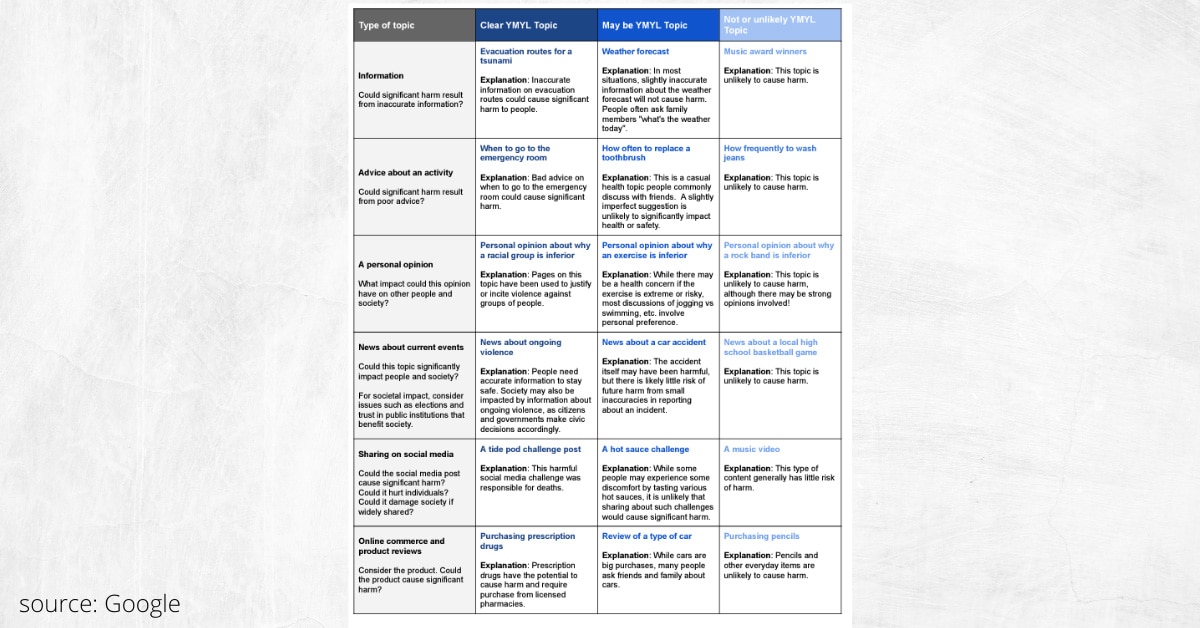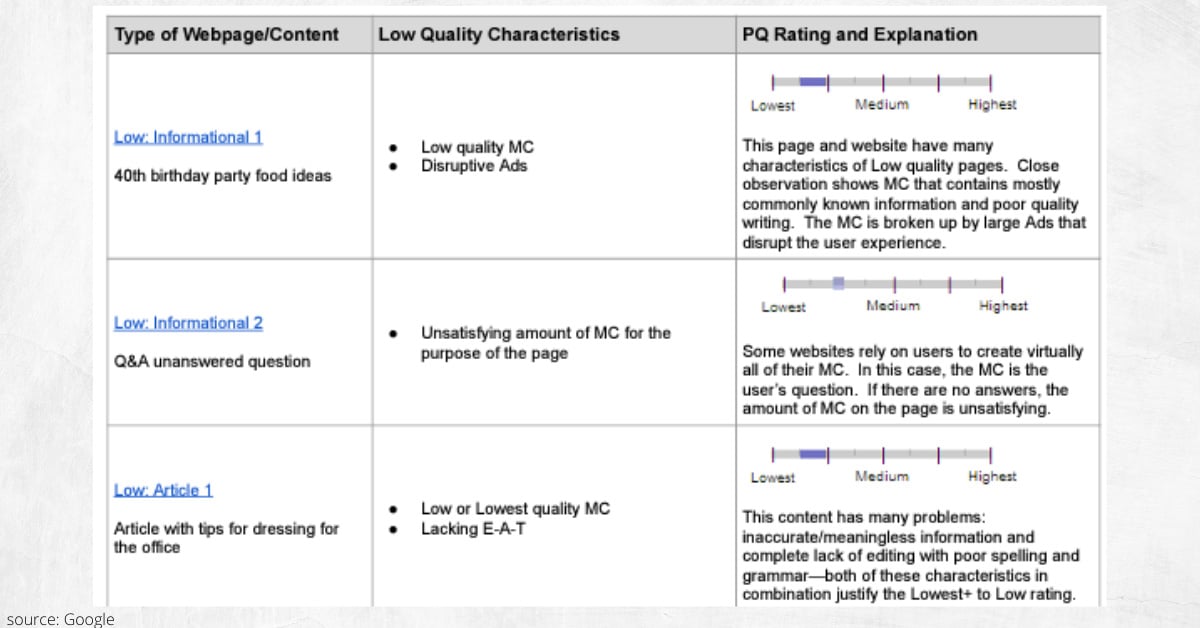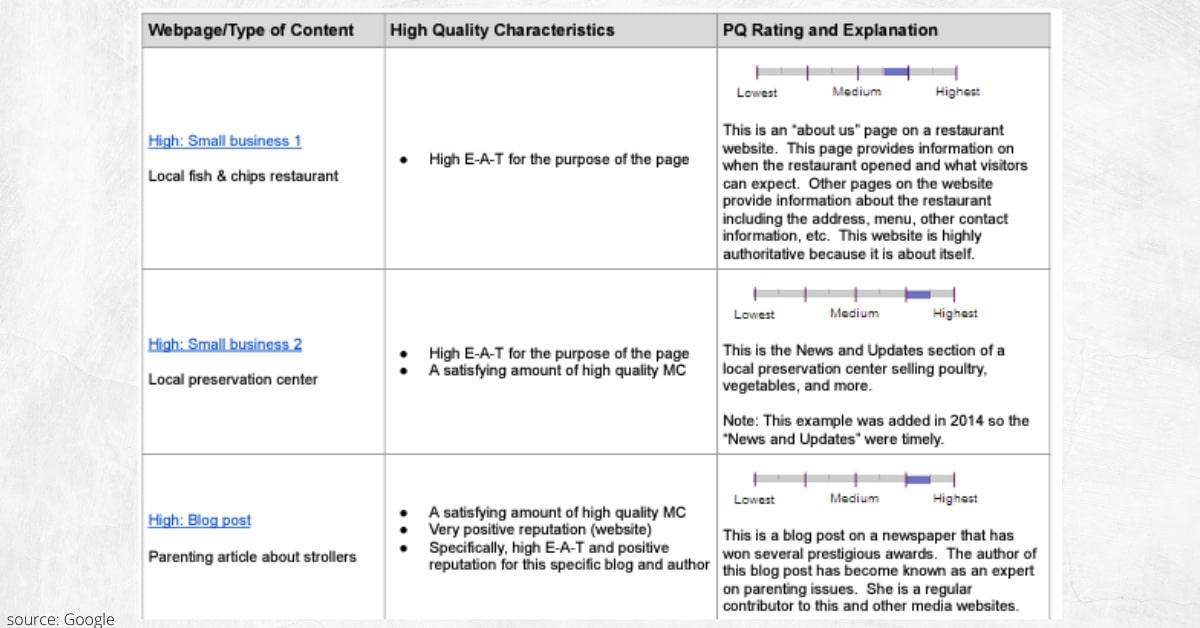Google announced several updates to their Search Quality Rater Guidelines, and it’s pretty clear what they are trying to accomplish. In this article, we’ll break down what’s changing and get a better understanding of what algorithms Google wants to see as it relates to E-A-T.
What is Google Search Quality Rater?
There are over 14,000 quality raters, and its purpose is to make sure Search is running relevant results from the more reliable sources available. These raters provide insights and evaluate pages against their guidelines to make sure everything is working as intended. It also helps raters determine how successful everything is running and if improvements need to be made.
The quality level of content is determined by evaluating which information best demonstrates E-A-T (expertise, authoritativeness, and trustworthiness). This rating system is constantly being tested to see how well the search results match that specific query. The information that is fed back to Google helps them to improve search.
Google says these raters are instructed to consider the extent to which the result:
- “fits” the query
- is comprehensive
- is up-to-date
- comes from an authoritative source
- satisfied the user, or whether the user would want to see additional results
The bottom line is if we create content that meets the user intent, then these are the types of pages Google wants to rank well.
New Updates To the Search Quality Rater Guidelines
Google provided very clear definitions for what it means for content to be YMYL (Your Money, Your Life) and what it looks like to lack E-A-T when determining whether a page is low-quality.
More Emphasis on YMYL Topics
Google has restructured its definition of YMYL, and places the focus on the “YMYL topic” instead of the “YMYL page.” These topics will now be evaluated to determine if they present a “high risk of harm” that can significantly impact the “health, financial security, or safety of people, or the welfare or well-being of society.” The “who” may be harmed is defined by the person reading the content, other people impacted around the viewer, or groups of people or society as a whole. This could potentially be a reference to violent, extremist, or terrorist content.
Content that presents YMYL topics with a very positive reputation is given the highest quality rating. This type of reputation is often based on prestigious awards or recommendations from known experts or professional societies on that particular topic. YMYL reputation is based on evidence from experts and professionals who can verify the information or who have used the website to make purchases. For pages on YMYL topics, a low-quality rating comes from anything that is misleading or has the potential to harm people.
Google wants to ensure that content that could significantly impact a searcher’s life is of the highest quality. If your website covers any of the topics of YMYL, they absolutely need to be demonstrating strong E-A-T. These topics are now being rated on a spectrum, with instructions to determine is a topic is:
- clearly YMYL
- definitely not YMYL
- something in between.
Here’s the chart they give with specific examples that help us decide where our topics fall:
They also give specific instructions to determine if a topic is YMYL:
- Would a careful person seek out experts from highly trusted sources to prevent harm? Could even minor inaccuracies cause harm? If yes, then the topic is likely YMYL
- Is the specific topic one that most people would be content with only casually consulting their friends about? If yes, the topic is likely not YMYL
Low-Quality Pages
Google revamped its definition of what it means to be a low-quality page. Low-quality is any content that’s lacking important information or demonstrates a problematic aspect. The biggest change with Google’s recent update is that the level of E-A-T required for the page content depends entirely on the topic itself and the purpose of the page. Google also implied that may want to see more information about who created the content for a clearly YMYL topic. They mentioned throughout the guidelines the importance of being recognized by others online as experts in your topic.
Google also updated a few places in the guideline to say that low-quality content can be found on academic websites, authoritative websites, and. government websites as well. They also mentioned in a few places that pages intended to manipulate people into action for the benefit of the website while causing harm to others are to be seen as low quality. Here are a few examples of low-quality page content:
Lacking E-A-T (Expertise, Authoritativeness, Trustworthiness)
Google further defined its definition of what it looks like to lack E-A-T when determining whether a page is low-quality:
“Informational [main content] on YMYL topics is mildly inaccurate or misleading.”
Google stated that the level of E-A-T a page requires depends on the purpose and the topic of the page. If the page discusses YMYL topics, E-A-T is the most critical. Even if a website has a high reputation or uses authoritative or expert sources, the page can still present harmful content. Google stressed considering the purpose and the topic of the page. What is the risk of harm? Is there a need for high E-A-T to prevent harm?
For example, a tax form instructional video made by someone who has no clear expertise in tax preparation will be deemed low-quality. A shopping checkout page that has an insecure connection is another example of a low-level E-A-T page.
High-quality pages are those that provide a beneficial purpose and demonstrate a high level of E-A-T. Unique and original content will also play a factor in its quality rater, and ones that include a description of the primary sources on that particular topic. It must be original, accurate, comprehensive, clearly communicated, professionally presented, and should reflect expert consensus. Here are some examples of web pages that demonstrate high-quality characteristics:
Any type of website may have harmful MC (main content), which includes user-uploaded videos or posts to hacked pages. Because of this, pages should be evaluated and monitored closely for inaccuracies. This includes pages on government websites, academic institutions, charities, or other types of generally helpful websites.
Why These Changes Matter
Google has shifted its definition of YMYL and is now asking raters to consider the extent to which content can be harmful or misleading. It also further emphasized the importance of E-A-T when content is categorized as YMYL. The bottom line, the need for a page to meet the searcher’s needs is important. The information needs to be comprehensive, up to date, and from an authoritative source. YMYL topics that can be potentially harmful have more airtight criteria in order to demonstrate strong E-A-T. The takeaway of this all is that Google wants the end user’s best interests to be the number one priority.
We hope you found this article helpful. If your business needs a boost in its digital marketing presence or would just like to discuss your online business goals, please reach out to our team for a free digital consultation.





